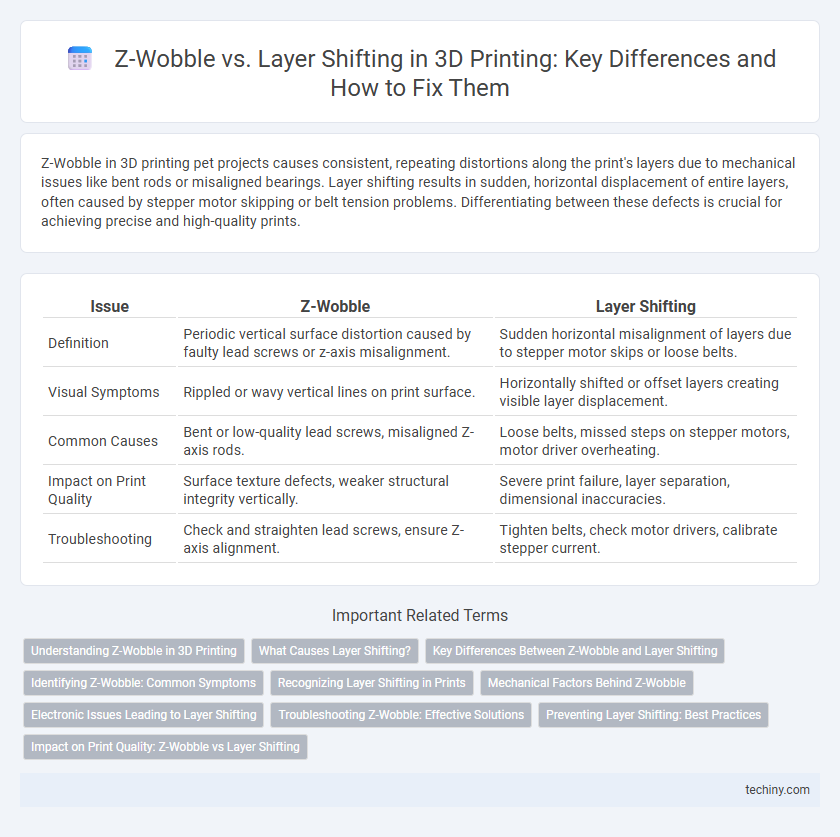Z-Wobble in 3D printing pet projects causes consistent, repeating distortions along the print's layers due to mechanical issues like bent rods or misaligned bearings. Layer shifting results in sudden, horizontal displacement of entire layers, often caused by stepper motor skipping or belt tension problems. Differentiating between these defects is crucial for achieving precise and high-quality prints.
Table of Comparison
| Issue | Z-Wobble | Layer Shifting |
|---|---|---|
| Definition | Periodic vertical surface distortion caused by faulty lead screws or z-axis misalignment. | Sudden horizontal misalignment of layers due to stepper motor skips or loose belts. |
| Visual Symptoms | Rippled or wavy vertical lines on print surface. | Horizontally shifted or offset layers creating visible layer displacement. |
| Common Causes | Bent or low-quality lead screws, misaligned Z-axis rods. | Loose belts, missed steps on stepper motors, motor driver overheating. |
| Impact on Print Quality | Surface texture defects, weaker structural integrity vertically. | Severe print failure, layer separation, dimensional inaccuracies. |
| Troubleshooting | Check and straighten lead screws, ensure Z-axis alignment. | Tighten belts, check motor drivers, calibrate stepper current. |
Understanding Z-Wobble in 3D Printing
Z-Wobble in 3D printing is a vertical artifact caused by imperfections in the Z-axis movement, often resulting from bent lead screws or misaligned rods, which creates repetitive horizontal patterns across the print layers. Unlike layer shifting, which involves sudden misalignment shifts along the X or Y axes primarily due to mechanical or belt tension issues, Z-Wobble specifically affects the vertical consistency and precision of the print. Understanding and diagnosing Z-Wobble requires inspecting the Z-axis components for mechanical defects and ensuring proper alignment of the threaded rods and stepper motors to maintain accurate layer height throughout the print.
What Causes Layer Shifting?
Layer shifting in 3D printing is primarily caused by mechanical issues such as loose belts, stepper motor skipping, or obstruction in the printer's movement path. Inconsistent stepper motor current or a misaligned pulley can lead to missed steps, resulting in horizontal layer displacement. Unlike Z-wobble, which affects vertical axis precision, layer shifting disrupts the part's lateral alignment during printing.
Key Differences Between Z-Wobble and Layer Shifting
Z-wobble in 3D printing causes vertical artifacts due to inconsistent Z-axis movement caused by bent lead screws or misaligned linear rails, resulting in repeated surface defects on layers. Layer shifting occurs when the X or Y axis abruptly moves out of sync, causing entire layers to be offset, typically due to loose belts, missed steps, or motor issues. Unlike z-wobble's periodic vertical distortion, layer shifting leads to a noticeable lateral misalignment of layers, significantly impacting print dimensional accuracy.
Identifying Z-Wobble: Common Symptoms
Z-Wobble in 3D printing manifests as periodic vertical banding or ridges along the Z-axis, causing surface imperfections and inconsistent layer lines. Common symptoms include uneven layer thickness, visible horizontal rings, and a subtle wobble effect on cylindrical prints. Distinguishing Z-Wobble from layer shifting is essential; layer shifting causes horizontal displacement of layers, whereas Z-Wobble results in vertical inconsistencies along the print height.
Recognizing Layer Shifting in Prints
Layer shifting in 3D prints is characterized by a sudden horizontal displacement of entire layers, resulting in a noticeable misalignment in the print's geometry. Unlike Z-wobble, which causes consistent vertical oscillations or ridges due to screw or rod imperfections, layer shifting produces abrupt step-like shifts between layers. Identifying layer shifts often involves observing abrupt breaks in the straight lines or edges of the model, indicating issues such as loose belts, skipped steps, or motor malfunctions.
Mechanical Factors Behind Z-Wobble
Z-Wobble in 3D printing primarily stems from mechanical issues such as bent lead screws, misaligned Z-axis rods, or uneven motor couplings, causing periodic artifacts along the Z-axis. These mechanical distortions result in consistent ripples or oscillations visible on vertical surfaces. In contrast, layer shifting is usually caused by skipped steps in the stepper motors or belt tension problems, making mechanical stability of the Z-axis crucial to prevent Z-Wobble defects.
Electronic Issues Leading to Layer Shifting
Layer shifting in 3D printing often results from electronic issues such as faulty stepper drivers, unstable power supplies, or loose wiring, causing sudden misalignment during layer deposition. Unlike Z-wobble, which manifests as vertical artifacts due to mechanical imperfections in the Z-axis lead screw, layer shifting presents as horizontal displacement caused by missed steps from the stepper motors. Diagnosing electronic problems by inspecting stepper driver temperatures, verifying stable current settings, and ensuring secure connector contacts is crucial to preventing layer shifting and maintaining print accuracy.
Troubleshooting Z-Wobble: Effective Solutions
Z-Wobble in 3D printing occurs due to imperfections in the Z-axis lead screw or misalignment, causing vertical ridges and print quality degradation. Troubleshooting involves checking for bent or damaged lead screws, ensuring proper alignment of the Z-axis, and tightening all related hardware components to eliminate play. Implementing anti-backlash nuts or upgrading to a higher quality lead screw can effectively reduce Z-Wobble and enhance print stability.
Preventing Layer Shifting: Best Practices
Preventing layer shifting in 3D printing involves securing the printer's frame and ensuring all belts and pulleys are properly tensioned to avoid mechanical slippage. Regularly lubricating linear rails and checking stepper motor drivers for overheating reduces unexpected movements that cause layer misalignment. Utilizing consistent print speeds and calibrating the printer's firmware settings also enhances print stability and prevents layer shifting.
Impact on Print Quality: Z-Wobble vs Layer Shifting
Z-Wobble causes vertical artifacts and uneven layer lines due to inconsistencies in the Z-axis movement, significantly degrading surface smoothness and dimensional accuracy. Layer shifting results in horizontal misalignment of layers, producing visible shifts or steps that disrupt the overall print structure and compromise mechanical integrity. Both defects adversely affect print quality but differ in their directional impact and underlying mechanical causes.
Z-Wobble vs Layer Shifting Infographic

 techiny.com
techiny.com